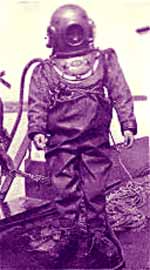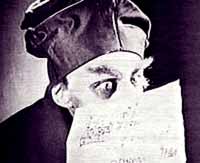|

II. The second way of becoming a sympathiser is not that of the simple souls.
It is perfectly possible, in these days of universal education, for a creative artist to find himself confronted by certain theoretical problems at a very early stage in his development. He may well find that he has to solve some such problems, and arrive at some intellectual formulation, before he can create anything: — in direct contrast to the simple souls, who first create something, and then make a formula about it. For example, he may well ask himself such questions as these: ‘This activity will bring in little money, if any ; it will contribute nothing to the solution of my most direct problems; why, then, does the impulse to this activity persist?’ ‘Granting that in me this impulse exists, why does it apparently confine itself to so few people ; are we who suffer from it abnormal? If so, what has caused our abnormality? How can it best be overcome, by yielding to the impulse, or by resisting it? If by yielding, what kind of creative activity will give it the most complete and economical satisfaction?’’ All these questions might very reasonably occur, in one form or another, to any educated person, and the kind of answer given to them would influence very deeply the kind of creative work which might be produced.
Now anyone occupied with such questions at any time and in almost any place during the last two decades has been compelled consider, at least, the claims of psychoanalysis to furnish a general theoretical background for the solution of his problems. those who have considered psychoanalysis most fully have generally found it more apt than any other system for their purpose. This has been the case with the official surrealists, and it has been the case with a number of independent artists.*
* I have omitted from the main line of my argument any consideration of the other main theoretical basis of surrealism — Marxism and the philosophic system of Dialectical Materialism. This has been done — perhaps very wrongly — partly for simple reasons of space, but chiefly because no independent worker who started from this point of view alone would ever approximate to the surrealist position, because he would almost inevitably remain within the official Communist limits, and would therefore bitterly oppose surrealism. The starting point must be psychoanalysis alone; this can develop into, and derive great assistance from. Dialectical Materialism. But with the present official Communist attitudes, the process is not reversible — unhappily.
What is the relation between the group who have worked with this theoretical basis, and scattered individuals who have used the same basis? How different are their conclusions? How similar is their work? These seem to me to be the real questions about surrealist sympathisers. Obviously they can only be settled — if they are ever settled — by discussion and negotiation. But as a preliminary to such discussion, it would be wise to define the orthodox psychoanalytic theories about art, as far as they go, so that it would be possible to see who departs from them, and how. The following notes are intended to indicate some of the main aspects of this orthodox doctrine.

III. a. The whole position is based on the acceptance of the hypothesis of causation, on the assumption that any observed phenomenon has a cause: that this cause is of a material kind (i.e. not an act of God in any sense): and that it is theoretically possible to ascertain this cause or causes, with varying degrees of probability.
This hypothesis rules out at once all ideas of ‘inspiration,’ ‘aesthetic intuition,’ since they imply the notion of free-will: — the artist, by a special dispensation, creates something out of nothing, something which cannot be ‘explained away’ in terms of its causes.
Like any other phenomenon, the work of art has causes, and these can be ascertained theoretically. It may happen, of course, that it is at the moment impossible, through defects in experimental technique etc., to ascertain these causes with any degree of certainty. But that is no reason at all for supposing that they cannot be ascertained at any time.
b. The difficulties of discovering the causation of artistic activity have already been roughly indicated in the questions put into the mouth of the educated artist. It appears that art as an activity contributes nothing to the upkeep of the individual.; it rarely obtains for him a sufficiency of money for rent and food, and does nothing to gratify sexual requirements.
Now it should be noticed that these difficulties are created by regarding man from a purely biological point of view, as an organism in an environment, with the usual implications of such a picture. And as long as this point of view is maintained, it is hard to see how the difficulties can be solved. A poor solution is suggested without much conviction by biologists and physiologists, who point to the existence of ‘play-activity’ in animals: — a kind of activity apparently without aim such as food or sexual satisfaction. Art might be the human equivalent of such play-activity, but there are obvious differences which make the parallel almost worthless: — for example, the play of animals involves muscular activity, perhaps in itself pleasurable, or serving as a motor discharge of internal stimulation (e.g. glandular), but most forms of artistic creation involve only a negligible amount of muscular movement.
c. Psychoanalysis suggests solutions, in the first place by replacing the biological conception of man by a conception of man by a conception of its own — a new picture, in which the ‘organism’ of biology becomes only one part of the human individual, his conscious mind, while the environment is a double one, the outside world, and the inside world — the instinctual forces within the individual. The task of this organism* is not a simple one of direct war with the environment, as in the biological picture, but the much more complicated one of mediation between the two environments, whose demands always conflict in some way.
* This use of the word organism to describe only a part of the inside of an animal skin would only disturb those who have never tried to define exactly ‘organism.’
This picture of the human situation is more useful than the biological one in any consideration of cultural factors, since culture is peculiar to man, and is obviously related with the characteristic which differentiates him from other animals — the great development of consciousness. Biology, in neglecting this characteristic — in having no technique for dealing with it — must necessarily fail to see the peculiar nature of the problems of man. Psychoanalysis may not be the only way of approaching these problems, but at the moment it is the clearest.
The peculiar difficulty of satisfying human instincts appears to result from the fact that impossible conditions are attached to their satisfaction. For example, in the typical case, the infant is stimulated in a number of ways by its mother, and associates pleasure closely with her (e.g. in suckling, washing, and frank caresses). In the terms of Pavlov, the presence of the mother conditions the reflexes of pleasure. But it may happen that in later life, the individual fails to abolish this state of affairs, or to establish new conditions for his pleasures. He may continue to require the presence of the mother quite literally, and is then debarred from direct discharge of his feelings by those incest-taboos which seem to be so fundamental in human society. Or it may happen that at the infantile stage, some portion of the body other than the normal erotogenic zones is very much over-stimulated, and behaves as if it were erotogenic; obviously if this condition continues into adult life it can produce a serious situation, again by attaching impossible conditions to instinctual satisfaction.
To some extent, even normal human beings suffer from these difficulties. Fortunately, however, there is a way out of the difficulty. The instinctual forces do not seem to care very much if the conditions for their fulfilment are provided in actuality, or in phantasy. That is to say, they will generally be satisfied if the situation to which they are accustomed is presented in the form of vivid memory-traces, worked up into a fairly coherent and life-like imitation of reality. Dreams provide the most universal example of this process. In them, instincts find fulfilment in phantasy-situations. In the waking life of primitive peoples, magic of all kinds does the same thing. And in the waking life of more civilised peoples, art, the lineal descendant of magic and religion, takes over the same function. Psychoanalysis has described a large number of parallels between dreams, primitive myths and rituals, and civilised art; it is unnecessary to repeat these in detail, but it must be understood that they form the basis of the theory of art based on psychoanalysis.
d. There is one major difficulty in developing this theory more fully. I have begged the question by saying above ‘even normal human beings suffer from these difficulties.’ What are normal human beings? There seems to be good reason for believing that the general situation is common to all men — the difficulties face everyone. But it is also clear that some people surmount them much more successfully than others, and that some reactions to the situation are much better than others. Yet the criteria of success, and of the value of the reactions, are very obscure. For example, there are many striking similarities between art and hysteria. In hysteria, parts of the body are made to represent dramatically the situations of unconscious phantasies: — the intestine plays complicated games with its contents, instead of digesting and excreting them, the skin, instead of recording stimuli in the ordinary way for the guidance of the organism, develops anaesthesias and paraesthesias which interfere with its ordinary function, and serve the ends, apparently, not of utility, but of pleasure, and the muscles exhaust themselves in taking up positions which have no useful purpose. In fact the instinctual forces treat the body as a piece of plastic material, and shape it into forms which have a definite meaning. The plastic artist appears to do very much the same thing, except that he employs material from the external world instead of his own body. But is this an essential and important difference between the hysteric and the artist?
Similarly the world created by a poet or a painter may approximate very closely to the worlds created by people confined in asylums. What is the difference between the two? Is there a real difference?

IV. I have said that these are only rough notes, and no complete conclusion is to be expected from them. On the whole, however, to return to the original subject — that of sympathy with surrealism — it seems probable that the surrealists and their sympathisers should be able to find a considerable body of common doctrine of a very useful and important kind in psychoanalytic theory of art. It will, however, consist mainly of parallels drawn between various expressions of the unconscious instinctual forces, and the problem of distinguishing between normal and abnormal, social and asocial expressions remains almost untouched, both by psychoanalytic theory and by surrealism. It is here that the difficulties and differences of opinion will occur: — and it is here, probably, that dialectical Materialism will perform its most useful work.
|
